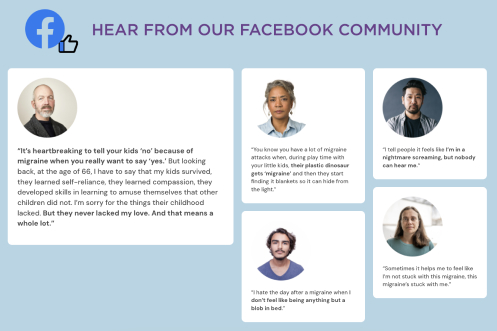When a migraine treatment strategy fails, your options are far from limited
In the same way that everyone experiences migraine differently, not every treatment plan works for every person. While it can be extremely frustrating to try one treatment after the next, there is hope for those living with migraine to find relief. Dr. Richard Lipton is Director of the Montefiore Headache Center and Neurologist at the Albert Einstein College of Medicine. We asked him how to set realistic treatment goals, and when it’s time to move onto a new option.
Finding the Right Migraine Treatment Plan
Start with a Proper Diagnosis
Various headache types—migraine with or without aura, chronic or episodic migraine—have different characteristics, which may mean a different treatment plan. “The subtype matters,” Lipton said, “because the treatment needs to match the subtype of migraine.” If your diagnosis is chronic migraine, OnabotulinumtoxinA (Botox®) is effective, but it is not approved for use if your diagnosis is episodic migraine. People can read about the characteristics of various headaches, he said, and then confirm that the diagnosis they were given corresponds to their experience.
Treat the Attacks Early
The key to stopping a migraine in its tracks is to treat it as soon as you feel the onset of pain and recognize you’re developing a migraine attack, Lipton said. However, at that point, the digestive system may be totally paralyzed, and the medication just sits in their stomach until the attack is over—a reason to try non-oral options such as a nasal spray or injection. “I know patients strongly prefer oral treatment,” Lipton said, “but if your digestion system is paralyzed or if you experience nausea and vomiting, you just need to find another way to get the medication in.” And often, he said, the medicine a patient uses to acutely (as-needed or on-demand) treat a migraine is actually the source of the problem. “A patient who is taking an over-the-counter medication that contains caffeine to treat their migraine on a daily basis may not get better,” he said. “The very medicine they take to relieve their pain triggers the next headache.”
Adopt a Preventative Treatment Plan
Because of the challenges with treating migraine acutely, Lipton likes to recommend preventive treatment, primarily for those who have at least four headache days a month. Once a person starts on an oral preventive medication, the important thing to remember, Lipton said, is that they start on a low dose, which should be gradually increased. “It might be a commitment to trying it for three months,” Lipton said, assuming the side effects do not outweigh the benefits. “To make a judgment about whether the treatment works, you need to gradually increase the dose and wait for the treatment effects to emerge,” he said. “Give the drug time to work.”
What if a treatment doesn’t work?
Treatment failure is often a product of miscommunication and misunderstanding, perhaps about a person’s symptoms or about what someone actually needs to treat their specific type of migraine. In other words, it may not actually be a failure at all.
A key part of understanding treatment failure, said Lipton, is redefining success. A preventive treatment plan will inevitably lead to disappointment if the expectation is to never have another headache. Instead, Lipton said, a reasonable goal for treatment is to decrease a person’s headache days by 50% or 75% or reducing the intensity of the headaches by 50%-75% and allowing acute medications to work faster and more effectively. This will “minimize the time that headache is interfering with ability to function.”
How can I learn from a Failed Treatment?
The keys to turning treatment failure into success: paying close attention to your symptoms, maintaining proper “headache hygiene,” and communicating regularly with your headache specialist. Getting as specific as possible with headache start and end times, symptoms, medication taken (including dosage), and response to treatment will not only help uncover helpful patterns that could provide insight into appropriate treatment, but it also will help uncover associations between triggers and headaches, Lipton said. “The problem with trigger factors is that there are a lot of them and they vary widely from person to person.”
Keeping a headache diary is one way to track symptoms and also identify potential triggers that could be creating challenges with treatment. The diary makes it easier to practice good “headache hygiene”—changing lifestyle behavior such as regularly exercising and proper nutrition, and avoiding triggers that could exacerbate migraine symptoms. Ultimately, these best practices for overall health can help reduce migraine symptoms and increase the effectiveness of treatment.
How can I communicate more effectively with my doctor?
Remember to share with your doctor how migraine actually impacts their lives—from having to miss work to not being able to take care of their child to missing out on important life events.
“Tell the doctor how your headache affects your life, the impact that your headaches have that’s most important to you,” Lipton said. “The goal of treatment is to relieve your pain and restore your ability to function. Using those endpoints that the patient defines as most important to them becomes the way a health care provider and a patient together can measure success.”









































































